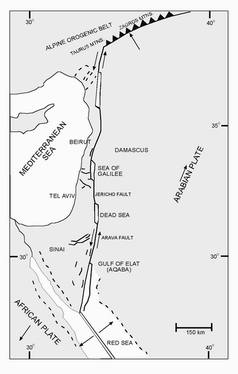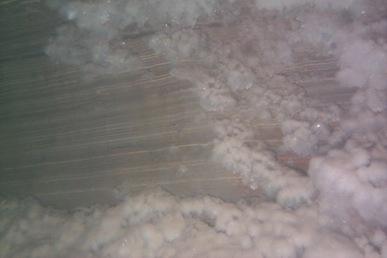| Mission Statement | | | History | | | The Dead Sea Ecosystem |
| Tectonic Framework The Dead Sea is situated within a unique region which is most interesting for many scientific disciplines, above all to earth sciences. At about 410 meters below sea level, the Dead Sea is the lowest point on earth. It is located at the center of the Dead Sea fault valley - a large feature which extends over 1000 km from the southern tip of the Sinai Peninsula to the Taurus mountain in Turkey and is the most prominent tectonic feature in the Middle East. |
...... |
 Tectonic map of the area
|
Geodynamic Laboratory
Throughout the its geological history, the Dead Sea fault valley was occupied by a series of lakes that disappeared and reappeared over time due to climatic and geological changes in the area. The last of these lakes, known as Lake Lisan, stretched from the northern Arava Valley to the Sea of Galilee. About 15,000 years ago it dried up, leaving behind what is known now as the present-day Dead Sea.
 Laminated
seasonal varves under the Dead Sea ( ~100m)
|
Climatic Fluctuations Climatic changes have caused considerable fluctuation in the level of the Dead Sea water. Sediments were deposited in the various lakes that occupied the area as laminated evaporitic and detrital varves. These seasonal deposites (dark = winter, light = summer) also indicate climatic fluctuations and are excellent sensitive recorders of paleoseismic fault rupture and activity. |
The Unique Waters of the Dead
Sea
Almost nothing can survive in this water except
highly specialized green algae and red archaeobacteria which are of
great scientific interest. Due to the low elevation of the Dead Sea
region much of the sun's ultraviolet radiation is filtered by the
deeper atmosphere. This effect, along with the lake water, is believed
to be efficacious in the treatment of the skin disease psoriasis.
|
 Red
halobacteria on the Dead Sea floor at a depth of ~100m
|
Active tectonic processes that control all aspects of the Dead Sea have created an environment that has influenced the course of human history as the critical land bridge between the continents of Africa and Asia. The historical and archaeological associations of this area are extensive. To name but few, it is in this region that Jericho, the oldest city in the world is located, the Dead Sea scrolls were found and Sodom and Gommorah once existed. Many historians and archaeologists believe that the region has much to yield in regard to biblical understanding.
The
region is thus of considerable scientific, economic and historical
interest, with many important and interesting problems to study. This
is why the Minerva Dead Sea Research Center was established at Tel Aviv
University.